I’ve had some questions about how I put together my Jedi costume, which is not of any particular character that appeared in the Star Wars universe, but follows the guideline of what a Jedi would have worn in the Old Republic. This kind of costume is called a “generic Jedi” in the Rebel Legion organization, of which I am a member. I made my costume according to the Rebel Legion Jedi Costume Standards, which is a useful reference even if you want a costume for fun and not for RL approval. (Please note, I am not a RL judge and this post reflects my own experience making my costume and is not an official guide of any sort).
The fun thing about doing a generic Jedi is you get to put a lot of your personality into it. You can choose your own colors and there are different kinds of shapes that are allowed. I’ll discuss some of the options available to you in each section.
The basic parts you need for a Jedi costume are:
- Outer tunic (the beige part of my outfit)
- Tabards (the blue parts that go over my shoulders and down the front)
- Obi (the blue sash around my waist)
- Pants or skirt
- Belt
- Boots
- Lightsaber
- Lightsaber clip on belt
For RL approval you need at least 3 out of these 4 items:
- Inner tunic (the white part of my outfit)
- Two or more (leather or resin) pouches
- Food capsules (the colored things on my belt)
- Hooded robe
I didn’t want to hang too many things on my belt so I opted to have only one pouch and fulfilled my requirements by having the other items. (If you are petite you may have trouble fitting two pouches and eight food capsules onto the sides of the belt and have to opt for one pouch and four food capsules).
My inner and outer tunics, pants, and robe are made of linen. The obi and tabards are wool. These materials were personal preferences due to breathability and durability but natural materials are not required if you are on a budget.
The RL Costume Guide linked above has suggested colors; Jedi tend to be earth-tones so you’ll see a lot of brown, black, gray, beige, etc. but other colors are approvable. My blue ensemble is not particularly common but still allowed.
OUTER TUNIC:
The outer tunic is similar to a kimono in concept in that one side folds over the other side and there are big sleeves. 

You can see the opening on the right side here.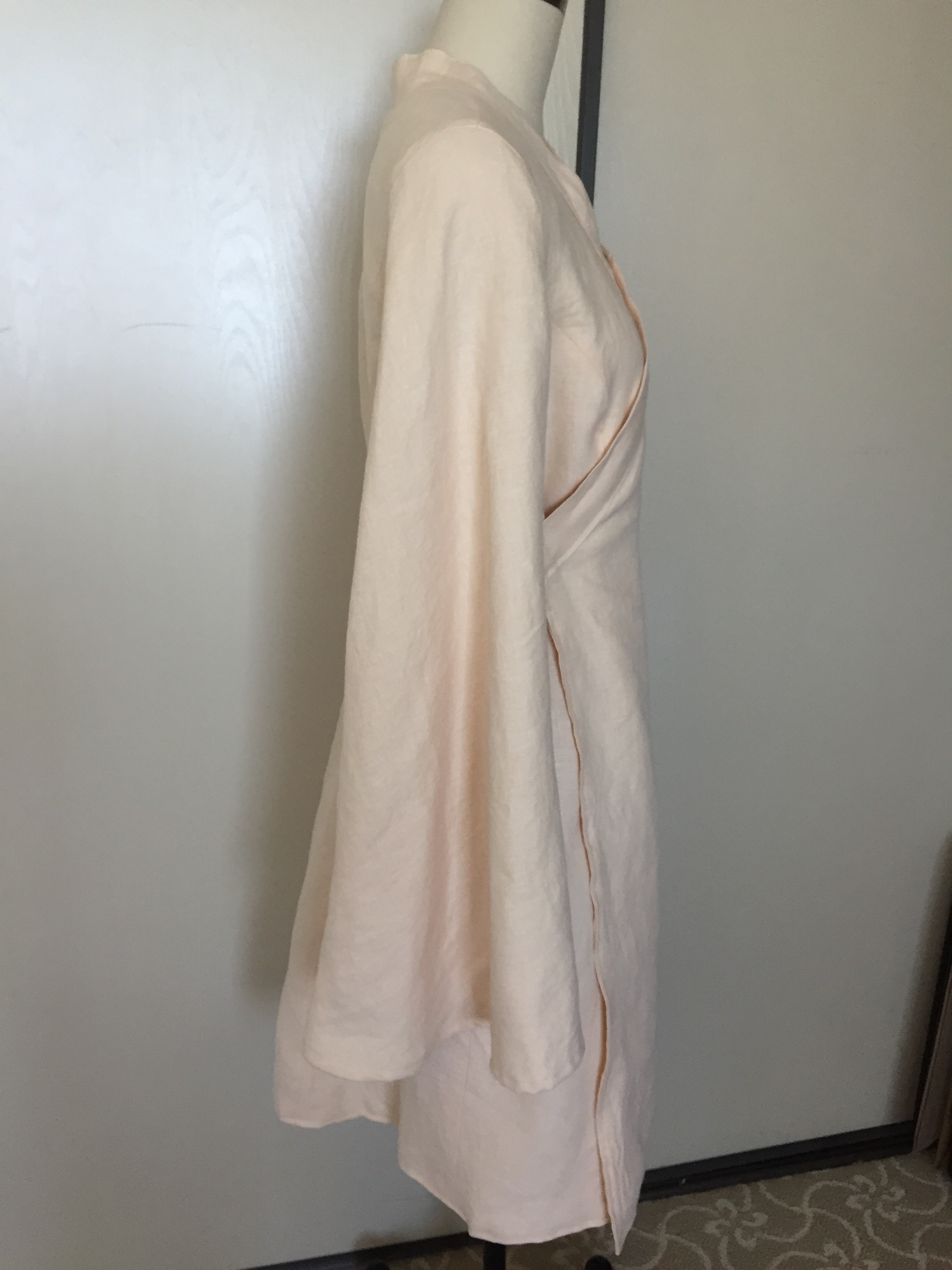
There are lots of tutorials and free patterns online for Jedi robes and tunics, so I will not reproduce them here. However, most of those are meant for male or unisex figures. They assume you have a boxy tunic that will be fitted to you with the belt, but creates some extra bulk at the waist. I opted to have a tunic with curved princess seams in the front and back to be more figure flattering. If you are not female-bodied or you want to save time by not worrying about extra seams, the free online Jedi tunic patterns are great. Otherwise, I would modify a wrap dress pattern for your Jedi.
I already had this McCalls M6940 Game of Thrones pattern (affiliate link) for a cosplay project so I modified it:
- Start with View A (the picture on the right).
- Tape the skirt hip gore (yellow part with the lion) pattern piece to the skirt hip (red part above it) pattern piece so that you can use it as one big pattern piece. You should not have that extra horizontal seam at your hip on your Jedi tunic.
- Shorten the skirt. My preference is above knee-level but you can make yours shorter or longer. (For RL approval it will need to cover your butt at least). You can also have a “hi-lo” tunic where the back is longer than the front.
- Make a wide band (about 2 inches wide) for your collar instead of the narrower one in the pattern.
- Use different sleeves. The Jedi sleeves are big cone shapes like wizard robes. I already had Simplicity 8723 Harry Potter robe pattern (affiliate link) so I borrowed the sleeves from that pattern, but made them longer. (For RL approval your sleeve should be knuckle-length).
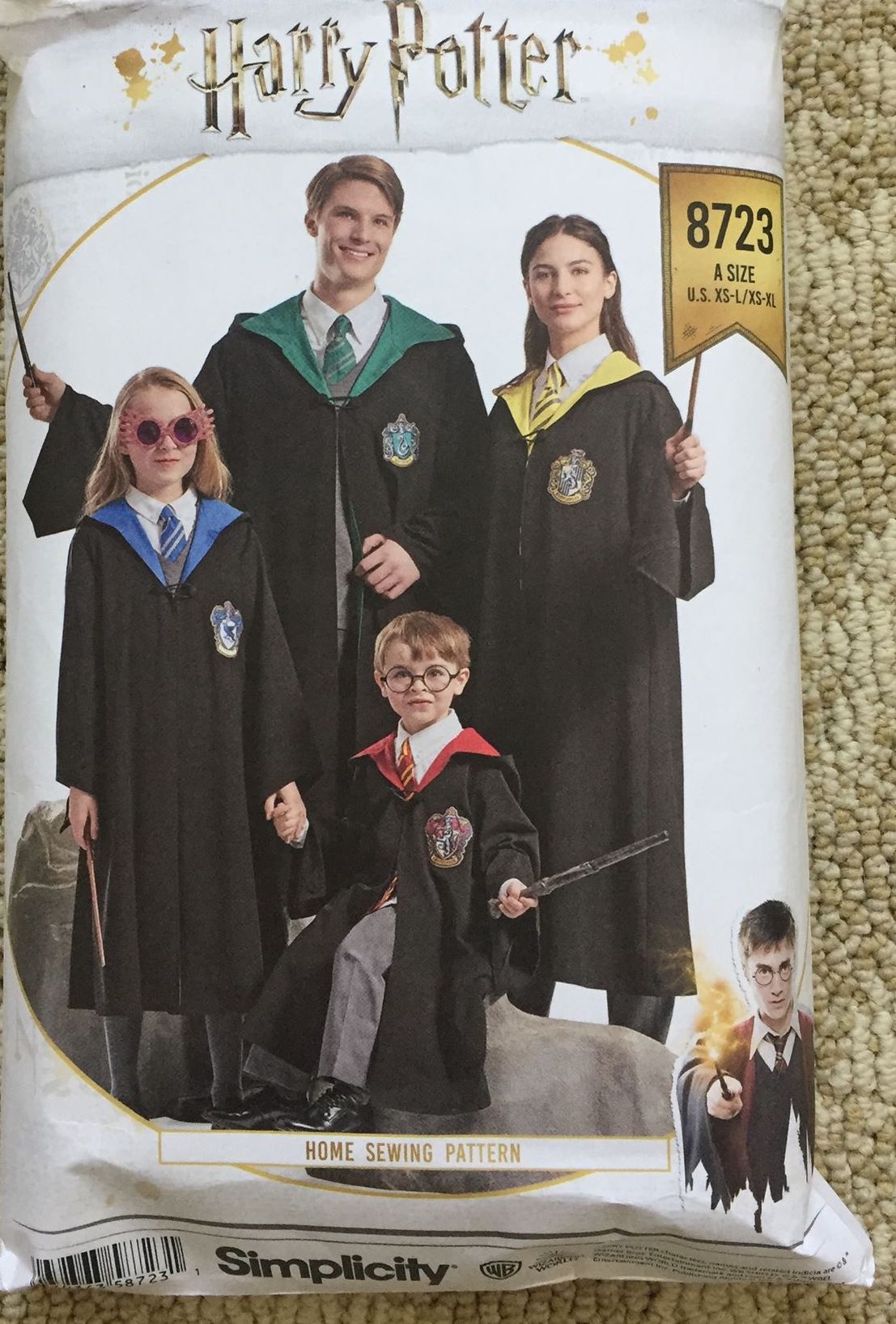
- Closures: instead of visible ties as shown on the McCall’s pattern, you want to have hidden closures on your Jedi tunic. I put hooks and bars on the right side of my tunic, and then a hidden ribbon tie on the inside left for extra security.


Unless your fabric is thick I recommend lining your tunic to give it better drape. A thin, flimsy tunic is going to look a little off if you want to look like an Old Republic Jedi or get RL approval. (If you are doing this as a casual Halloween costume then by all means do what’s quick and easy if you prefer!) I used two layers of “blanched almond” 100% linen from Fabricmart for mine. I have not used it myself but I have heard that Joann Fabrics has a “linen look” linen-rayon blend that is pretty good if you don’t have the budget for full linen. Crinkle cotton gauze is also a popular choice. You may be able to find a good polyester/cotton blend but it may be hot to wear.
INNER TUNIC:
Although not required I highly recommend having one. It’s a layer that you can launder without having to wash your whole costume each time. You can either make a full shirt or just a dickey (false shirt with just a collar and a bit of a front and back). The important part is that the collar shows. Mine is a full wrap shirt with a band collar about 2 inches wide. 
As you can see it is a very simple shape, with just a snap closure, because you won’t be seeing most of it while the costume is worn. My pattern is self-drafted but you can modify any basic shirt pattern. The easiest thing would be finding a wrap blouse pattern with a V neck to start with, but if you have some basic sewing skills you can extend one “flap” of the shirt pattern over and cut out the neckline to be a V shape.
Mine is made out of linen because it wicks moisture. Wearing lots of Jedi layers can get warm!
TABARDS:
When worn, tabards look like two pieces that go over your shoulders and down the front and back of your outer tunic. They are NOT straight rectangles because they need to be angled to sit right. You can cut them out as Y-shapes but I preferred to have pieces where the seam was hidden by the obi because it saved fabric. Here is an in progress shot to show you what I mean. The top pieces need to be long enough to cover the front and back; there is NO shoulder seam for Jedi tabards.
The exact dimensions are going to depend on your height and how broad your shoulders are. They should be wide enough to extend past your shoulders slightly. Mine are 5″ wide but I am not a very large person. For the upper pieces cutting out rectangles about 6″ x 36″ wide was a good starting point for me. I am 5’6″ tall and that was enough fabric to have 0.5″ seam allowances and a lot extra to trim off when angling the ends. (The tabards are double thickness so cut 4 identical rectangles out).
The bottom half of the tabard is where you have a lot of chances to show off your personal preferences.
- The ends can be squared off, pointed, or rounded. Mine are pointed and curved on one side.
- The length can vary but must be at least as long as your outer tunic (for RL approval).
- You can have the tabards meet and become one piece hanging in the front.
- The back tabards can cross or not.
- They can be fabric or leather.
- You can put decorative symbols on them with paint or embroidery.

For the lower tabards I started with 4 rectangles that were 6″ x 28″, which like the upper tabards were enough for seam allowance and extra for trimming. My curve starts about 6 inches from the end.
I constructed the tabards by sewing the right sides together, turning them right side out, and top-stitching. They are the same on the front and back.
OBI:
The obi is the wide sash around your waist. The RL standards say that the obi should be the same width as your tabards or about the 3 times the width of your belt. I did the first option so my obi is 5″ wide, but yours should be proportional to your height and shoulder width. The length will depend on your waist measurement. You’ll want to have add at least several inches for overlap in the back, plus more for seam allowance.
The easiest obi is just a long rectangle, but a lot of people like to add texture and visual interest. Mostly this means pleating or scrunching up the top layer horizontally. I put in a series of diagonal tucks. I have not seen anyone else do this so I want to note that even though I got approved, if you are going for RL submission your judge’s opinion may vary. 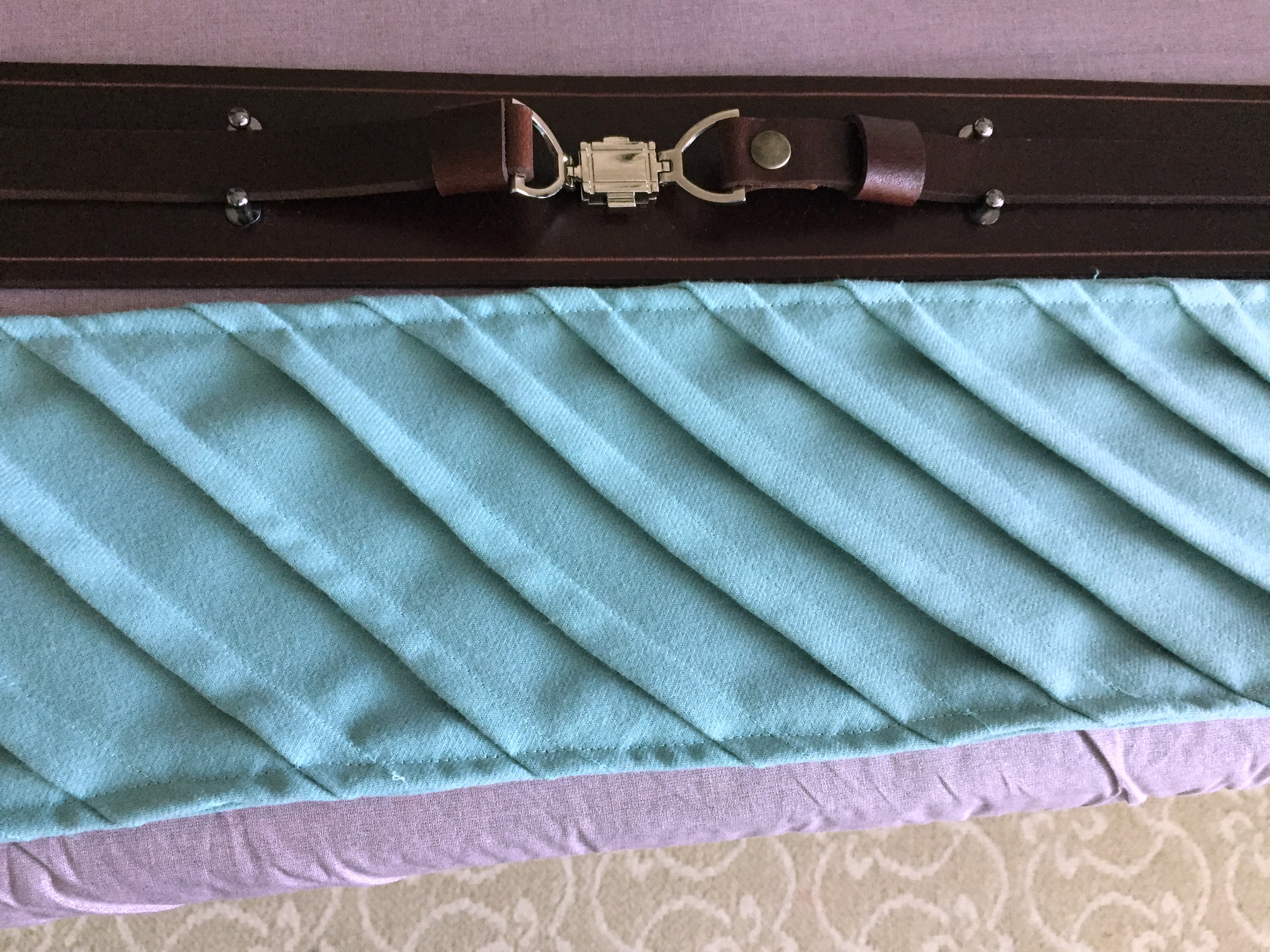
The obi cannot have any visible closures. You can use velcro, hooks and eyes, or snaps but they must be hidden in the back overlap. (I used 2 large snaps). Some people also do not add closures and rely on the belt to keep the obi closed, but that makes it a little harder to get dressed.
I recommend sewing your tabards to your obi. (Then you put it on like a backwards vest, with the obi closure in the back). This will keep them from shifting while you are wearing them and they will hang symmetrically without having to adjust them each time. If you are clever about it, when you sew the tabards to the obi you will form small pockets between the tabards and obi for your credit cards and cash, or stickers and trading cards to pass out to kids.
BELT:
Leather and pleather belts are both approvable, but I chose a leather belt for durability since I plan to wear this costume a lot. My belt was custom-made for me by Mag Mel Creations on Etsy. David does really great work and has wonderful customer service; I highly recommend his shop.
The classic Jedi belt consists of a wide belt with a skinny belt down the middle, with a buckle and studs holding the skinny belt in place. My belt is dark brown leather and 2.5 inches wide but the width can vary depending on your height. There are different buckle types you can get but mine is the “Obi-wan” style. The buckle in front is not actually the main closure for the belt. Jedi belts overlap in the back and closes with studs (mine), Velcro, or snaps that are then hidden by a loop of leather that slides over the opening. 
Your belt can be brown or black but should match your boots.
BOOTS:
Like the belt, your boots can be brown or black but need to coordinate with the belt. If you are following RL standards:
- They should be tall but not extend over the knee.
- Boots should be low-heeled.
- Laces are not allowed.
- Zippers are ok but need to be facing the inside of your leg.
- Decorative buckles are ok but not if they are overly numerous.
- I have an elastic gusset down the back of my boots, which are considered ok if they are discreet and blend in.
Like the belt, boots can be leather or pleather, but if you are going to be trooping a lot or marching in parades get some good quality leather boots to be kind to your feet!
I have very narrow calves so my options are limited, but I was able to get “Gabi” boots from Slimcalfboot.com during a sale. They also have a sister company called Wideshaftboot.com.
PANTS:
Getting pants are the easiest part of the ensemble! Only a little bit between the bottom of your tunic and top of your boots show, so there’s a lot of leeway to choose pants. You may even already have some in your closet that work.
- Pants should be plain and in a solid color.
- If there are pockets they should be hidden by your tunic. (No cargo pants with pockets down the side of your leg).
- Whether they close with elastic, drawstrings, or buttons doesn’t matter because it won’t show. (Your outer tunic is supposed to be long enough to cover your butt).
- Skirts are also allowed by RL instead of pants but they are supposed to be long enough to not expose any skin.
I made my own pants to match my robe, but many people buy nursing scrubs or use khakis. My pattern is self-drafted but you can use a pajama pants pattern and then taper the legs a bit.
I added 2 pockets to the back big enough for a phone and a wallet. My waistband is elastic because that’s a lot faster than putting in a zipper and placket. 
ROBE:
The robe is an optional item but fun! Jedi robes are very oversized with really large hoods and sleeves. I used the aforementioned Simplicity 8723 Harry Potter robe pattern (affiliate link) but made a few adjustments:
- Wizard hoods are pointed. Jedi hoods are rounded. You’ll want to cut off the pointy tip and round out the back of your hood pattern piece.
- You’ll need to cut your hood bigger by extending the pattern pieces in all directions. Jedi hoods are HUGE. Did I emphasize they are SUPER BIG? They are so large that when you wear them the sides of the hood cover your shoulders.

- When the hood is down, the back of it almost touches your butt. To get all that fabric into your neckline you’ll need to do big pleats. (Your hood does not need to be lined, but I did because I wanted all the seams and edges to be very neatly finished. I’ve seen Jedi with serged one-layered hoods get approved so it’s not necessary).

- The sleeves are humongous and long enough to cover your hands. If you are using the Harry Potter robe pattern you’ll need to extend the length of the sleeves.
- The robe should be close to floor-length. (The RL standard is no more than 2 inches off the floor). The HP robe pattern only goes to about knee length so you’ll want to lengthen the robe. Please note, if you plan to run, drop the robe!

POUCHES:
Jedi have leather pouches attached to their belts. (If you want to use it as a RL minimum extra you’ll need 2). The pouches are allowed to be pleather or resin. There is a lot of leeway to the pouches as long as they match the look of your belt. A lot of people use military surplus ammo pouches because they are easy to find and inexpensive. You may prefer to find a pouch large enough to hold a phone or wallet. I opted for a small pouch due to my proportions, and because I already put pockets in my pants.
My pouch is a military surplus leather slingshot pellet holder (affiliate link) that I darkened with a few layers of shoe polish and wax.

Some Jedi belt makers will also make you a custom matching pouch if you ask.
LIGHTSABER:
Lightsabers are a very personal item with lots of possibilities. As a generic Jedi and not a specific character you can pick a design that appeals to you instead of looking for screen accuracy. If you want a fun costume you can pick up a plastic lightsaber at a toy shop. If you want a nicer one with a metal hilt the cost varies wildly depending on design, if it has a sound board, if it can do multiple sound effects, if it can change colors, if you had a saber smith do custom engraving, etc. I’ve seen lightsabers cost anywhere between $50-$1000 or more. There are a number of companies out there making lightsabers so make Google your friend. 
However, if you are interested in mine, it is a YDD from Amazon (affiliate link), which was recommended to me as being good for small hands. At about $80 with sound effects it is a great deal. I like the smooth look because it’s comfortable to hold. As far as I can tell it is the same as the Kyojin Tiny Giant from Pach Store, but I have not purchased from that company myself.
LIGHTSABER CLIP:
There are two main ways to attach your lightsaber hilt to your belt depending on your lightsaber. If your hilt has a D ring then you will need a “hook” type of attachment and if your hilt has a Covertec wheel then you will need a Covertec-style belt clip (affiliate link).
I have a hook attachment for my belt. You can buy “Jedi lightsaber clips” but a really cost-effective way to get the look and function is to buy an archery quiver clip (which is used to hold the quiver of arrows to your belt) from a sporting goods store. Mine is a “Neet chrome belt clip” (affiliate link). One end hooks onto your belt and the other end is a hook for your D ring.

FOOD CAPSULES:
Clipped to the belt are also little metallic pieces called “food capsules.” If you are going for RL approval you will need at least a set of 4; some people have 8. I bought my Jedi food capsules on Amazon (affiliate link), and they come in a set of 8 but I only use 4 of them.
HOW MUCH FABRIC DO I NEED?
The amount of fabric you use will depend on your size of course, but to give you a rough idea this is how much I used (as a 5’6″ tall slender person):
All fabric was wide widths (about 54″).
HOW MUCH WILL THIS COST?
The cost of your Jedi costume will vary widely depending on what sort of materials you use, how fancy your lightsaber is, and whether your goal is to be Rebel Legion approvable or have a quick Halloween costume. I plan to wear this costume multiple times a year for many years and need to be comfortable during long hours so I invested in nice fabrics (all linen and wool) and high quality genuine leather boots and belt. Including my lightsaber (which was on the low end of the price range) I spent about $500. DON’T PANIC. If you use cotton or polyester fabric and pleather boots and belt I think you could put together a Jedi for $200, or even maybe $100 if you get creative at the thrift store. If you are on a budget I’d recommend going to a thrift store and looking for used boots there, and seeing what curtains and sheets you could use to make your garments instead of buying new fabric. If you have a bit of skill you can try your hand at making your own belt as well. (If you are not looking for RL approval you have a lot more flexibility in terms of faking the look with a store-bought belt). If you skip the robe, which takes up a lot of fabric, that will bring your costs down as well.
I wrote this guide with Rebel Legion approval in mind, but if you are not interested in that you can simplify or skip items. Also please keep in mind that your goals are your goals. Don’t let anyone make you feel embarrassed if you have a low budget, like unusual color combinations, or want a costume for fun and not for official approval.
Good luck and May the Force Be With You!
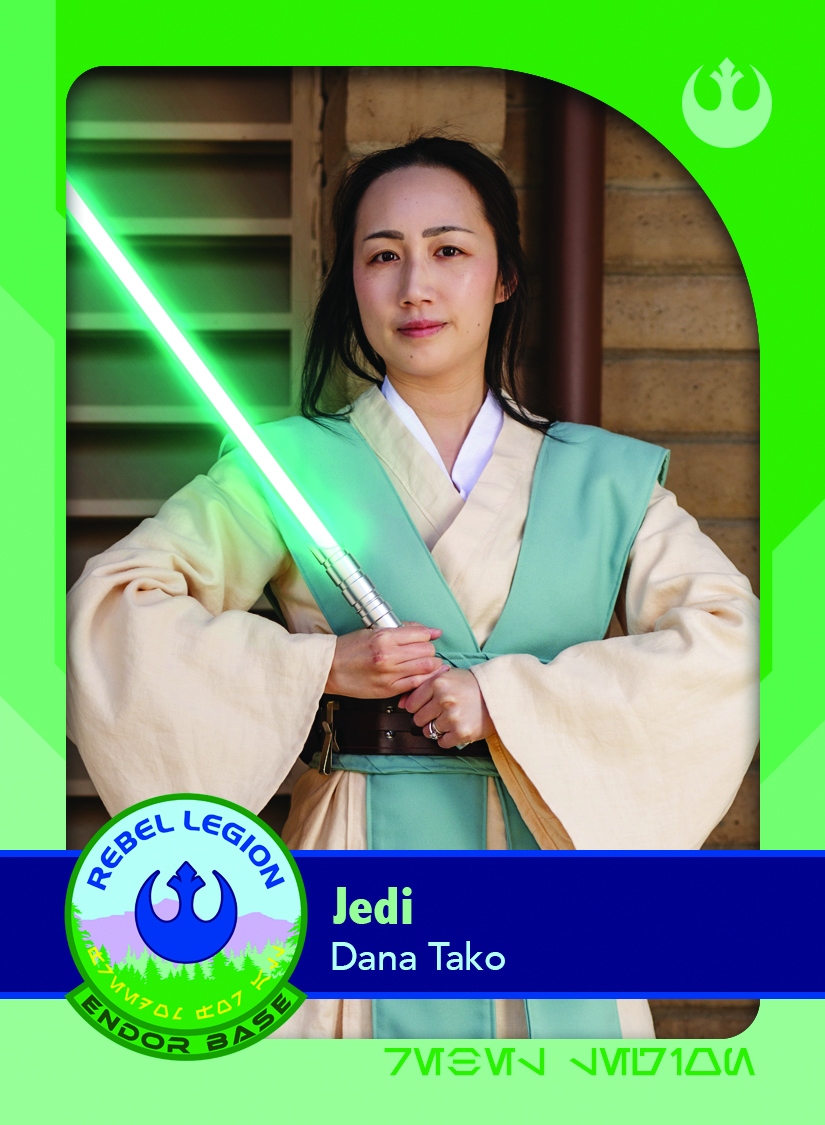
My Rebel Legion trading card, graphics by Colin Adams (OddViking)
HEY WHAT’S UP WITH ALL THESE “AFFILIATE LINKS”?
I am required to disclose that if you buy something through the Amazon link I get a small percentage of the sale that goes towards my domain registration fees and other costs associated with hosting the many photos on this website. (I don’t generate a profit on this blog; I just hope to break even). If you feel extra generous you can buy me a “coffee.” Thank you for reading!

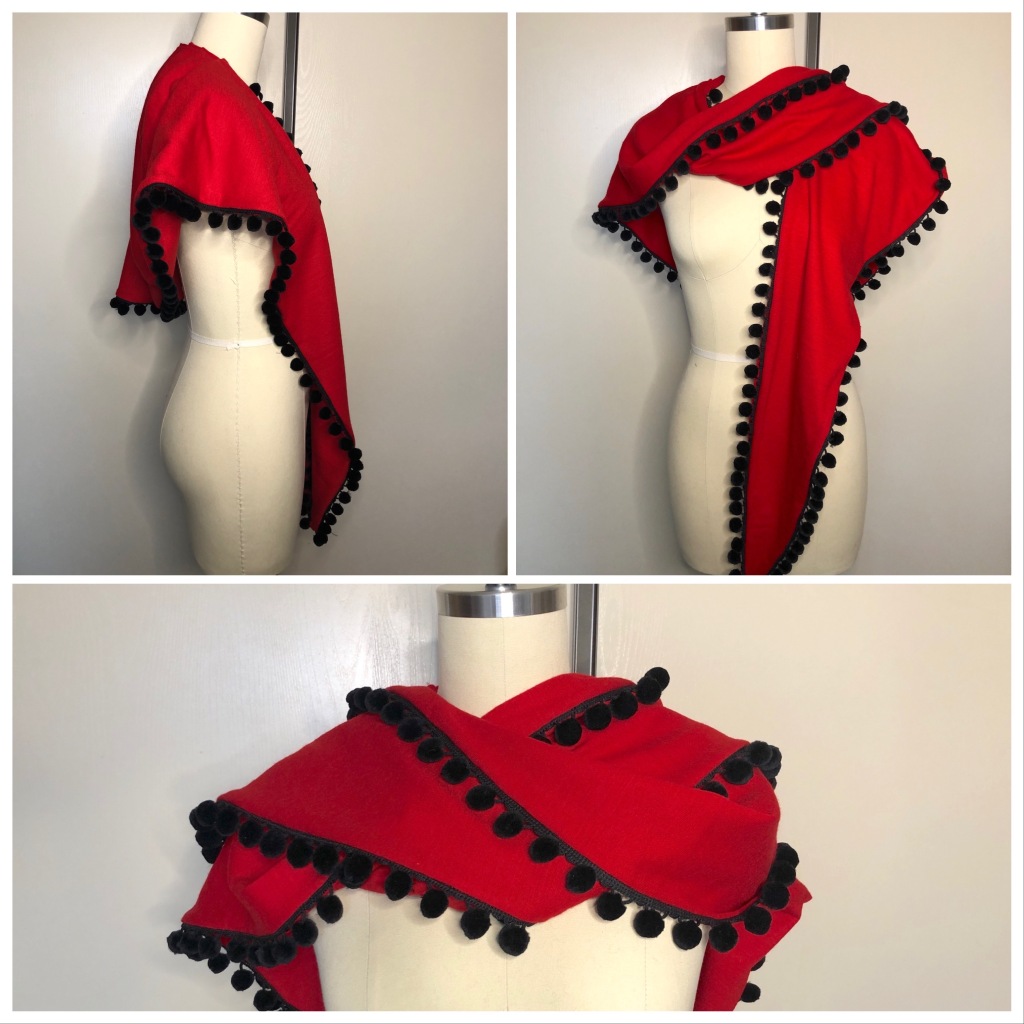






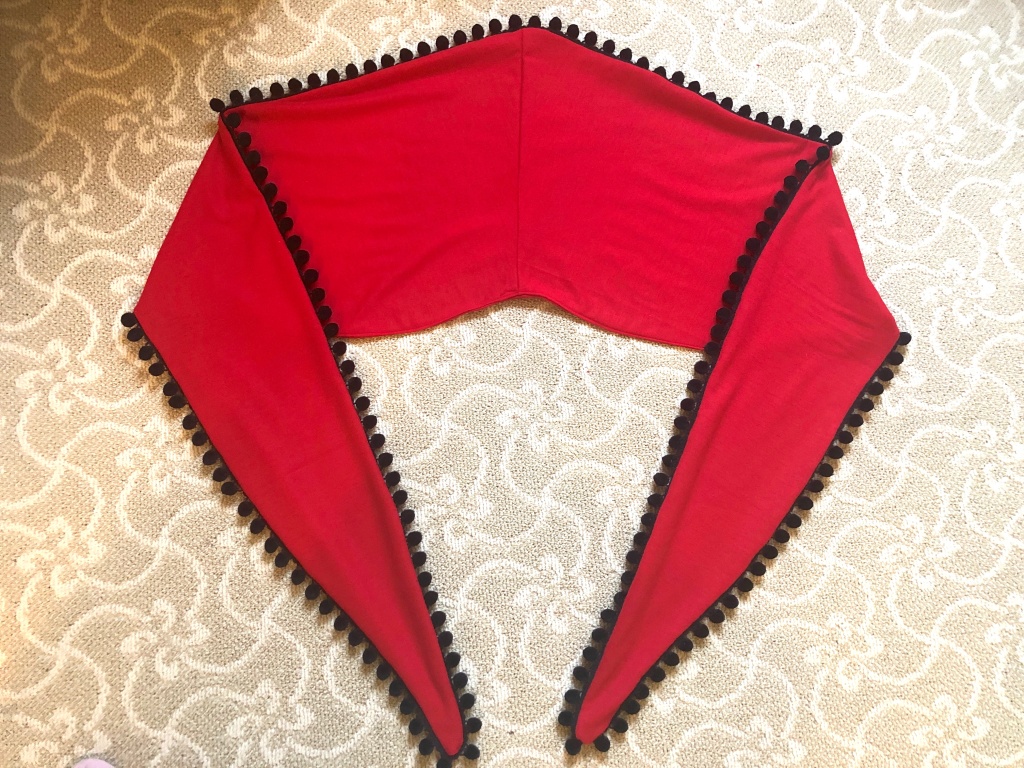







































 The skirt panel is faced with self-fabric and contains all the buttonholes while the buttons are sewn onto the pants. There are two options to attach the skirt panel. You can have one side sewn into the seam of the pants (which means you won’t lose the panel and you can make half as many buttonholes) or you can have the panel completely removable. If you have the panel attached you fold it over to one side and button it down. I opted to have the panel completely removable because my self-faced fabric folded over would have meant 4 layers of medium-weight wool and more bulk than I wanted. (If you use a lightweight wool or other fabric you don’t have to be concerned about that).
The skirt panel is faced with self-fabric and contains all the buttonholes while the buttons are sewn onto the pants. There are two options to attach the skirt panel. You can have one side sewn into the seam of the pants (which means you won’t lose the panel and you can make half as many buttonholes) or you can have the panel completely removable. If you have the panel attached you fold it over to one side and button it down. I opted to have the panel completely removable because my self-faced fabric folded over would have meant 4 layers of medium-weight wool and more bulk than I wanted. (If you use a lightweight wool or other fabric you don’t have to be concerned about that).































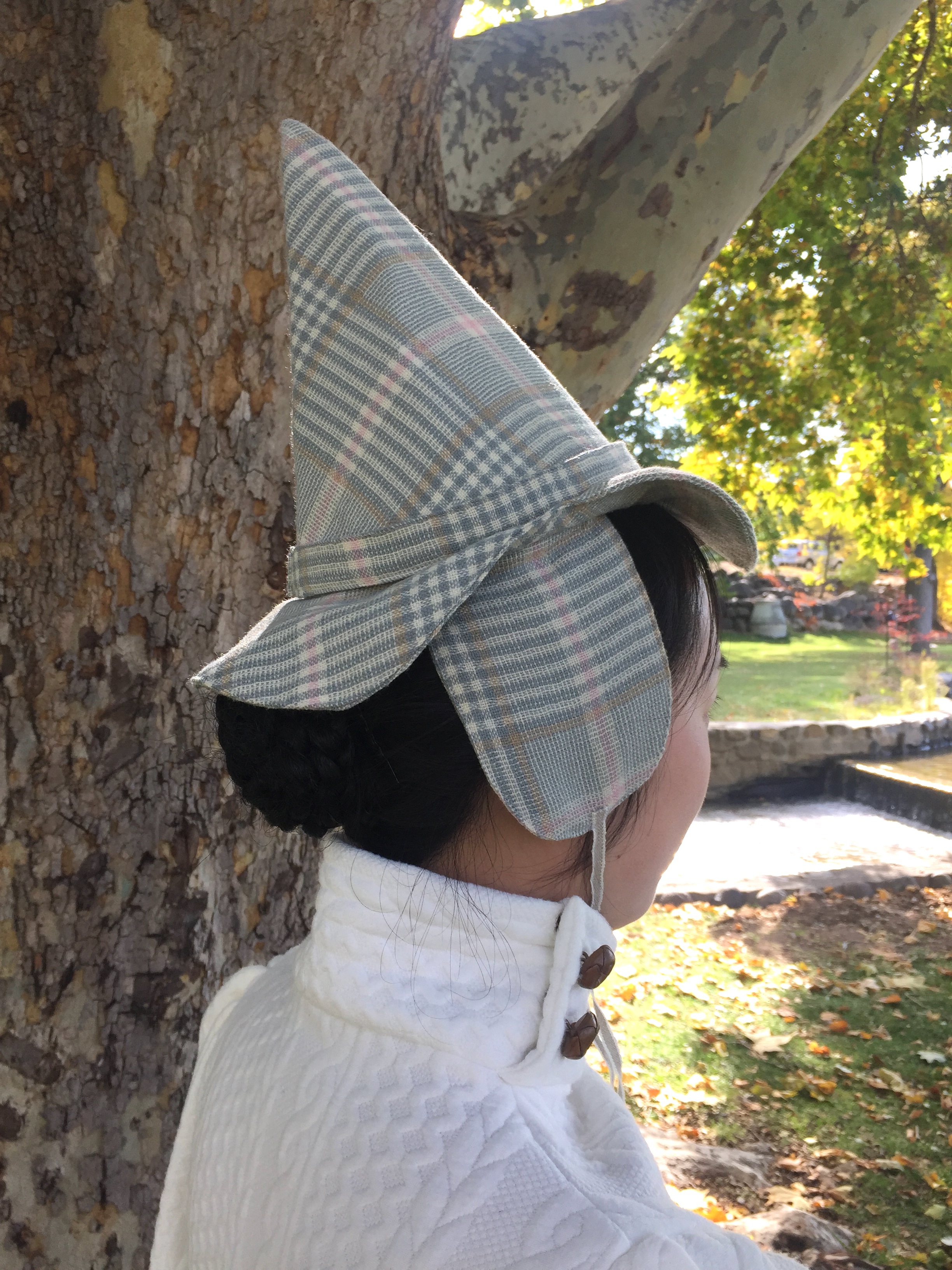











 The flaps can be worn tied up but do not meet in the back.
The flaps can be worn tied up but do not meet in the back.
















































